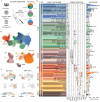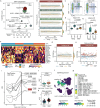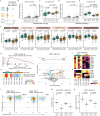This is a preprint.
Longitudinal Multi-omic Immune Profiling Reveals Age-Related Immune Cell Dynamics in Healthy Adults
- PMID: 39314416
- PMCID: PMC11419011
- DOI: 10.1101/2024.09.10.612119
Longitudinal Multi-omic Immune Profiling Reveals Age-Related Immune Cell Dynamics in Healthy Adults
Update in
-
Multi-omic profiling reveals age-related immune dynamics in healthy adults.Nature. 2025 Oct 29. doi: 10.1038/s41586-025-09686-5. Online ahead of print. Nature. 2025. PMID: 41162704
Abstract
The generation and maintenance of protective immunity is a dynamic interplay between host and environment that is impacted by age. Understanding fundamental changes in the healthy immune system that occur over a lifespan is critical in developing interventions for age-related susceptibility to infections and diseases. Here, we use multi-omic profiling (scRNA-seq, proteomics, flow cytometry) to examined human peripheral immunity in over 300 healthy adults, with 96 young and older adults followed over two years with yearly vaccination. The resulting resource includes scRNA-seq datasets of >16 million PBMCs, interrogating 71 immune cell subsets from our new Immune Health Atlas. This study allows unique insights into the composition and transcriptional state of immune cells at homeostasis, with vaccine perturbation, and across age. We find that T cells specifically accumulate age-related transcriptional changes more than other immune cells, independent from inflammation and chronic perturbation. Moreover, impaired memory B cell responses to vaccination are linked to a Th2-like state shift in older adults' memory CD4 T cells, revealing possible mechanisms of immune dysregulation during healthy human aging. This extensive resource is provided with a suite of exploration tools at https://apps.allenimmunology.org/aifi/insights/dynamics-imm-health-age/ to enhance data accessibility and further the understanding of immune health across age.
Conflict of interest statement
Conflicts of Interest. A.W.G. serves on the scientific advisory boards of ArsenalBio and Foundery Innovations and is a cofounder of TCura. All other authors declare no conflict of interest.
Figures







References
-
- Argentieri M. Austin, Xiao Sihao, Bennett Derrick, Winchester Laura, Nevado-Holgado Alejo J., Albukhari Ashwag, Yao Pang, et al. 2023. “Proteomic Aging Clock Predicts Mortality and Risk of Common Age-Related Diseases in Diverse Populations.” BioRxiv. 10.1101/2023.09.13.23295486. - DOI - PMC - PubMed
-
- Bates Douglas, Martin Mächler Ben Bolker, and Walker Steve. 2014. “Fitting Linear Mixed-Effects Models Using Lme4.” ArXiv [Stat.CO]. arXiv. http://arxiv.org/abs/1406.5823.
-
- Bayard Charles, Lepetitcorps Hélène, Roux Antoine, Larsen Martin, Fastenackels Solène, Salle Virginie, Vieillard Vincent, et al. 2016. “Coordinated Expansion of Both Memory T Cells and NK Cells in Response to CMV Infection in Humans.” European Journal of Immunology 46 (5): 1168–79. - PubMed
Publication types
Grants and funding
LinkOut - more resources
Full Text Sources
Research Materials
